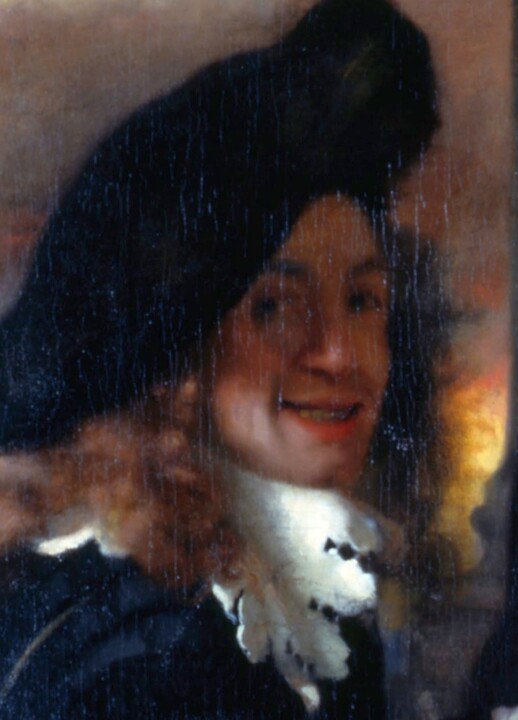 Johannes Vermeer, The Matchmaker (1656). Detail, presumed self-portrait of the artist. Dresden, Gemäldegalerie Alte Meister.
Johannes Vermeer, The Matchmaker (1656). Detail, presumed self-portrait of the artist. Dresden, Gemäldegalerie Alte Meister.
Johannes Vermeer (1632-1675) was a 17th century Dutch painter, famous for his genre works, landscapes and portraits. Little information is known about his life, but he is considered one of the most important and talented artists of the Dutch Golden Age.
Vermeer was born in Delft, the Netherlands, in 1632. His father was a prosperous art dealer and innkeeper, and his mother was a devout Catholic. Little is known of Vermeer's early life, but he probably studied under Leonard Bramer, a local painter. In 1653 he married Catharina Bolnes, a young woman from a wealthy family.
Who was Vermeer?
Vermeer began his career as a history and genre painter, but soon moved into portraits and house interiors, which are his most famous works today. His paintings are characterized by painstaking attention to detail, subtle use of light, and a limited but elegant color palette.
Vermeer lived a relatively low-key life and little information is known about him. He was married and had at least 11 children. He was also an active member of the Guild of Saint Luke in Delft, a professional organization for artists.
During his life, Vermeer never achieved great commercial success and often had to sell his paintings at low prices. After his death, his work fell into obscurity until it was rediscovered by art critics in the 19th century. Today, Vermeer's paintings are highly prized and are considered masterpieces of 17th century Dutch painting.
An innovative artist in Delf
Using innovative techniques such as the camera obscura, Vermeer created visual effects that were ahead of their time. He was also one of the first artists to use a limited color palette, creating unity and harmony in his works.
A new last name
His father, Reynier Janszoon, was originally known as "Vos" (fox in Dutch) in Delft, where he was a silk weaver and upholsterer. He ran an inn called "De Vliegende Vos" (the flying fox) where he sold paintings, carpets and tapestries.
From 1640 Vermeer took on the name "van der Meer" (of the lake in Dutch), probably following his brother's example. The "Ver" in "Vermeer" is actually a contraction of "van der" which is common in some Dutch surnames. Also, her father's surname was shortened from "Janszoon" to "Jansz". Vermeer's family has had different surnames over time, and the name "Vermeer" we know today is the result of contraction and renaming in the family.
The family environment
Reynier Janszoon, the father of Johannes Vermeer, carried out several activities during his life. He learned the weaving trade in Amsterdam, where he married Digna Baltens before moving to Delft, where they had two children. Reynier was a master caffa weaver and also served as an innkeeper from 1625. In 1631 he became an art dealer and joined the Guild of Saint Luke of Delft. Reynier also got in trouble with the law and was involved in a brawl in 1625, for which his mother paid part of the compensation to the victim. His family was also affected by scandals, such as his grandfather's involvement in a counterfeit money affair. Reynier died in debt in 1652, leaving his son Johannes with more debts than assets. However, despite these difficulties, the Vermeer family was known for its extreme solidarity.
His artistic training
Although no records of his apprenticeship are known, Johannes Vermeer was admitted as a master to the Guild of St. Luke in Delft on December 29, 1653, suggesting that he had trained for four to six years with a recognized master. Several hypotheses have been put forward as to the identity of this master, including Leonard Bramer, Evert van Aelst, Gerard ter Borch, Jacob van Loo and Érasme Quellin. Some have also raised the possibility that he studied under Carel Fabritius, one of Rembrandt's most gifted pupils, who lived in Delft in 1650. Vermeer's early paintings also show the influence of the Caravaggio School of 'Utrecht, and some have suggested that he studied under Abraham Bloemaert. However, neither of these assumptions is fully satisfactory, and Vermeer's ability to synthesize art suggests that he quickly assimilated influences to develop his own way.
Vermeer converts to Catholicism
On April 5, 1653, Johannes Vermeer announced his intention to marry Catharina Bolnes, a Catholic from a wealthy family. But their marriage faces reluctance, perhaps for financial or religious reasons, because Vermeer was brought up in the Protestant faith. The couple ended up getting married on April 20, 1653 in Schipluiden. It is possible that Vermeer converted to Catholicism to explain the lifting of the reluctance of the family of his future wife. Vermeer quickly integrated into the Catholic milieu of his in-laws, even though Catholicism was then a tolerated minority in the Netherlands. Some of his works bear witness to a specifically Catholic inspiration, such as Christ at Marthe and Mary, Saint Praxede and The Allegory of Faith.
In 1641, Maria Thins left her abusive husband and moved to Delft with her daughter Catharina, to a house in the Catholic quarter. After their marriage, Johannes and Catharina move in with her and have eleven children, four of whom die in infancy. The family enjoys relative prosperity thanks to the financial assistance of Maria Thins. The first names of the children appear in wills and were baptized in the Catholic Church of Delft. This large family constitutes a considerable burden for the couple and can explain their request for a loan in November 1657.
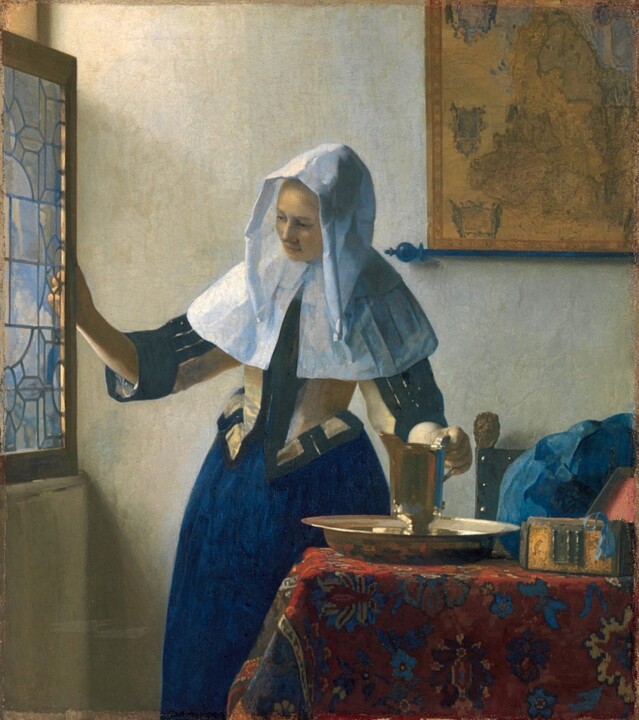 Johannes Vermeer, Young Woman with Ewer, New York, Metropolitan Museum of Art
Johannes Vermeer, Young Woman with Ewer, New York, Metropolitan Museum of Art
The career of the artist Vermeer
The Guild of Saint Luke
In December 1653, Johannes Vermeer became a master at the Guild of Saint Luke in Delft, which allowed him to freely exercise his art, to continue his father's trade in paintings and to take on pupils. Elected to head the guild in 1662 at the age of 30, he was reappointed the following year, before receiving this honor a second time in 1672. He was also called upon as an expert to authenticate a collection of canvases in The Hague in 1672, and concludes against the opinion of some of his colleagues that they are inauthentic.
The first orders
Vermeer was a slow painter, apparently producing no more than three paintings a year, or around 45–60 works over his entire career. It is possible that he mainly worked for individuals. He is known as the baker Hendrick van Buyten and the patrician tax collector Pieter Claesz. van Ruijven were two of his main sponsors. Van Ruijven, who was probably the first purchaser of many of Vermeer's works, could explain why his reputation did not spread further beyond Delft during his lifetime or after his death.
The difficulties
In 1672, the United Provinces suffered a serious economic crisis due to attacks by the French army and the English fleet. Maria Thins, who owned farms near Schoonhoven, lost her income due to the flooding of surrounding land. The art market also suffered a sudden stop. Vermeer, who had to support his large family, was forced to borrow 1000 florins in Amsterdam in July 1675. His death occurred in December of the same year, plunging his family into poverty. His wife Catharina has to pawn two of her husband's paintings to secure a debt. She sells 26 other paintings for 500 florins and declares bankruptcy in April 1676. Antoni van Leeuwenhoek is appointed curator of her property. During the liquidation, a merchant receives 26 paintings as pledge.
The Rediscovery of Vermeer's work
Vermeer was no unrecognized genius and his works continued to be sold and collected after his death. In 1696, during the sale of the Dissius collection, 21 Vermeer were sold at relatively high prices. In the 18th century, there was a craze for the Vermeers in the art market, despite the scarcity of his canvases. However, Vermeer has suffered from relative neglect by art historians, perhaps due to his low output and reputation limited to the city of Delft. It was mentioned by Dutch art theorists Gérard de Lairesse and Arnold Houbraken, but without much commentary. It was not until the beginning of the 19th century that its reputation spread beyond Holland, thanks in particular to its popularity with collectors.
Vermeer was rediscovered in the second half of the 19th century thanks to Étienne-Joseph-Théophile Thoré, who devoted a series of articles to him in the Gazette des beaux-arts in 1866. Thoré-Bürger was a radical democrat who admires Dutch genre paintings and the quality of light in Vermeer's interiors. He draws up the first inventory of the master's works, reattributing some to Pieter de Hooch. The end of the 19th century was marked by a real hunt for Vermeer's works, which were mainly acquired by politicians and entrepreneurs. Holland is experiencing a controversy linked to the sale of the Six collection, which featured La Laitière. Thoré-Bürger's catalog was then corrected by Henry Havard in 1888 and Cornelis Hofstede de Groot in 1907.
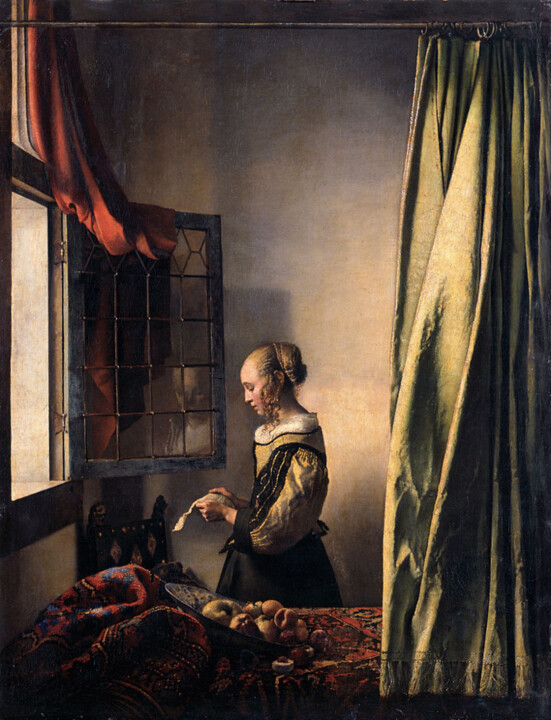 Johannes Vermeer, The Reader at the Window, Gemäldegalerie Alte Meister, Dresden
Johannes Vermeer, The Reader at the Window, Gemäldegalerie Alte Meister, Dresden
Vermeer's works
Landscapes and allegories
At the beginning of his career, Vermeer painted religious and mythological canvases to find a place within the guild of Saint-Luc, but he quickly abandoned this genre to explore other subjects. He painted two allegories, The Art of Painting and The Allegory of Faith, which are remarkable for their synthesis between realistic representation and symbolic meaning. He also created two landscapes, La Ruelle and Vue de Delft, considered his masterpieces. The View of Delft is particularly admired by Marcel Proust and Bergotte.
genre scenes
Vermeer is best known for his genre scenes painted on small formats which represent intimate, serene and "bourgeois" interiors. The characters are busy with their daily activities. Themes of love and vanity are ubiquitous in his paintings, but their meaning is open to interpretation. Some paintings, such as The Milkmaid or The Lacemaker, present models of virtue by promoting domestic activities. The paintings The Astronomer and The Geographer are different in that they depict a scientist at work, without female companionship. Representations of single women, such as Girl with a Pearl Earring, are not portraits, but rather a candid attitude or an exotic headdress.
The self-portraits
In the catalog for the Dissius sale of May 16, 1696, there was a reference to number 4 for a "portrait of Vermeer in a bedroom, with various accessories, of seldom so accomplished craftsmanship", which was probably a self-portrait. However, this painting is now lost. The only portrait of a painter we have is that of the back in The Art of Painting, although there is no evidence that Vermeer depicted himself on this canvas. Certain elements have, however, been put forward to suggest that The Matchmaker could be a disguised self-portrait, in particular the resemblance to the costume of the painter on The Art of Painting, the tradition of Flemish painting at the time of slipping a self-portrait within groups taking as subject the "prodigal son", the proximity to a self-portrait by Rembrandt from 1629, or even the angle of the representation, suggesting an image taken in a mirror. However, none of this evidence is completely conclusive.
Interiors
Vermeer's interior scenes are easily identifiable thanks to the recurring elements found from one canvas to another: characters, objects treated in still life, furniture, geographical maps and paintings hung on the wall. We can even recognize the same man in The Young Girl with a Glass of Wine and in The Interrupted Music Lesson. Vermeer often uses the same motifs, such as arm chairs with lions' heads and a lidded porcelain jug. He also reuses elements present in the family hearth, such as the vermeil ewer. The spaces depicted also have similarities, such as the pattern of the elegant black and white pavement, which is the same in several canvases. Vermeer often paints a foreground cluttered with objects to materialize the separation between viewer space and performance space. The geographical maps, copies of expensive maps, characterize the characters socially and signal the enthusiasm for this new scientific discipline. These recurrences form a coherent and recognizable work, although each painting offers a new scene or a new enigma. Vermeer lets the viewer guess the interiority of the characters, his painting being more contemplative than narrative.
The influences
Vermeer was influenced by other Dutch masters who specialized in painting interiors, including Gabriel Metsu, Gerard Ter Borch and Nicolas Maes. Although his technique may be inspired by that of Carel Fabritius, a pupil of Rembrandt who lived in Delft between 1650 and 1654, he is especially compared to Pieter de Hooch, who arrived in Delft around 1653. The two artists contributed to creating a style new genre of painting by reproducing the realistic effects of light and texture.
Effects and the camera obscura
Vermeer is famous for his perfect perspective, with no guide lines visible under the paint and no preparatory drawing. This technique led to the hypothesis that he used an optical device called a camera obscura, which was confirmed by several elements. The effects of blur and depth of field in his canvases are similar to those of photography, while the bold foreshortening effects show that Vermeer faithfully copied the images reflected by the optical device. The circles of confusion depicted in some of his canvases are more of an artistic technique, rather than the result of the camera obscura. The slight low-angle shots and the modest format of the paintings were also used to support this hypothesis. Yet even if true, this rational explanation is not enough to fully grasp the mystery of Vermeer's work, which continues to fascinate and move viewers.
Colors
Vermeer used a nimble brush to work with solid colors on large surfaces rendered thick. He carefully added layers of pigments and varnishes, which gave his painting that characteristic radiance and freshness. He was the only 17th century artist to use so much natural ultramarine, a very expensive pigment made from crushed lapis lazuli. In The Girl with a Glass of Wine, he used natural ultramarine for the underlay to match the shadows of the red satin dress. This way of working was undoubtedly inspired by Leonardo da Vinci. Even after his bankruptcy, he continued to use this expensive pigment for A Lady Seated at the Virginal. He also used natural umber and ocher for the warm light of a brightly lit interior. Vermeer was famous for his pairing of blue and yellow, for example for the turban in The Girl with the Pearl Earring, or the clothes in The Woman in Blue Reading a Letter.
Vermeer's works
- The Girl in the Red Hat: depiction of a young girl wearing a large red hat.
- The Milkmaid: representation of a young woman pouring milk into a jug.
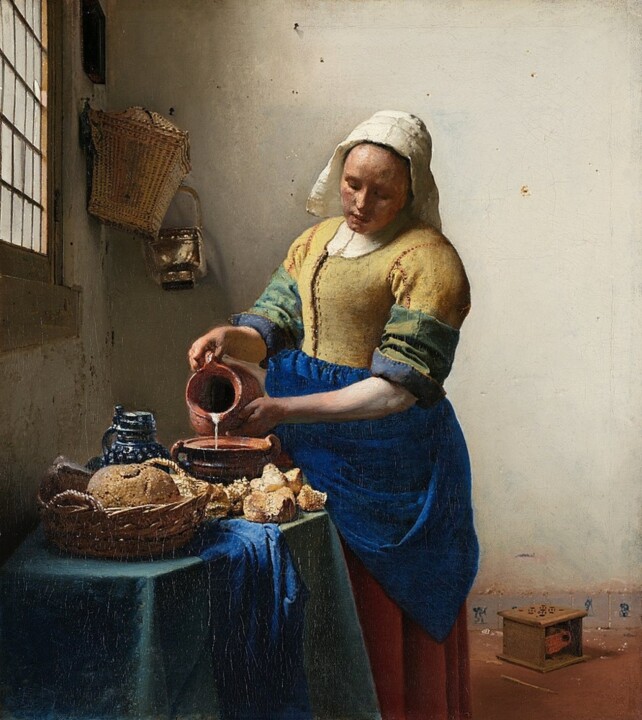
Johannes Vermeer, The Milkmaid, circa 1658-1661, Amsterdam, Rijksmuseum - The Woman in Blue Reading a Letter: representation of a woman seated in a room, reading a letter.
- The Young Girl with a Pearl Earring: depiction of a young girl wearing a pearl in her ear.

Johannes Vermeer, Girl with a Pearl Earring, Mauritshuis, The Hague - The Music Lesson: representation of a woman playing the harpsichord, accompanied by a man.
- The Concert: representation of two women and a man playing music in a room.
- The Love Letter: representation of a woman reading a letter, seated at a table.
- View of Delft: representation of a view of the city of Delft, with a river and buildings.
- The Woman with the balance: representation of a woman holding a balance, with a cluttered room of objects behind her.
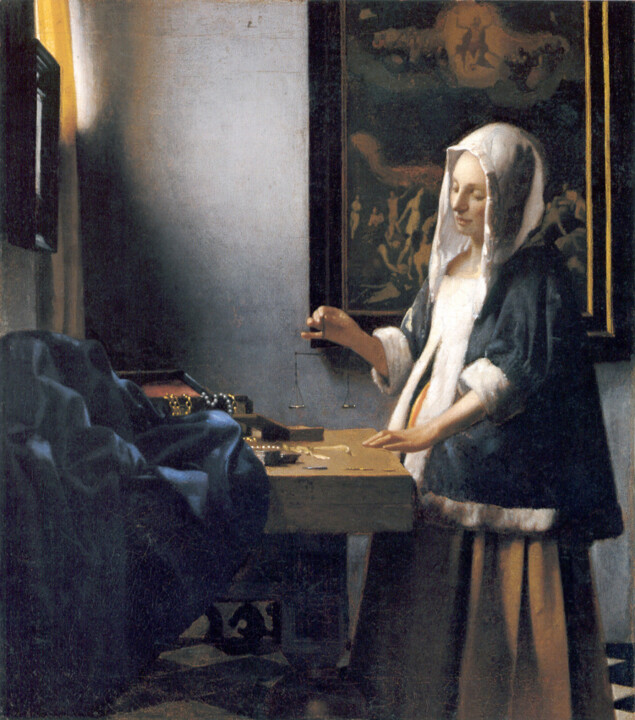
Johannes Vermeer, Woman with a Scale, Washington, National Gallery of Art - The Woman with the Guitar: representation of a woman playing the guitar.
- La Femme au lute: depiction of a woman playing the lute.
- La Femme à la puce: representation of a woman looking at a pearl necklace with a pendant in the shape of a chip.
- The Young Girl with a Flute: depiction of a young girl playing the flute.
- The Geographer: representation of a man studying a geographical map.
- The Art of Painting: representation of an artist painting a woman wearing a laurel wreath.
- The Mistress and the servant: representation of a woman seated at a table, accompanied by a servant.
- The Young Girl with a Glass of Wine: depiction of a young girl drinking wine.
- The Painting Lesson: depiction of an artist giving a painting lesson to a young woman.
- Sainte Praxède: representation of a woman holding a crucifix, in a room filled with objects.
- The Soldier and the Laughing Girl: depiction of a soldier from behind, accompanied by a young girl.
- The Allegory of Faith: representation of a woman wearing a crown of laurels, with religious symbols around her.
- The Young Woman with an Ewer: representation of a young woman holding an ewer.
- The Lost Letter: representation of a woman reading a letter, accompanied by a child.
- A lady seated at the virginal: representation of a woman seated at a harpsichord, with a room cluttered with objects behind her.
Vermeer's influences
Vermeer has inspired many artists in different fields of culture. Here are some examples :
Literature :
- Tracy Chevalier's novel Girl with a Pearl Earring (1999), which imagines the life of the young girl depicted in Vermeer's famous eponymous painting.
- Michel Butor's book, Vermeer (1973), where the author offers an in-depth analysis of the painter's work.
Movie theater :
- Peter Webber's film, The Girl with a Pearl Earring (2003), adaptation of Tracy Chevalier's novel, which traces the relationship between Vermeer and the young girl who would have served as a model for his painting.
- Jean-Pierre Cottet's documentary, Vermeer, le jour et l'heure (1996), which explores the life and work of the painter.
Music :
- Janis Ian's song, Jesse (1975), which evokes the narrator's fascination with the painting Girl with a Pearl Earring and imagines a love story between the painter and her model.
- Louis Andriessen's opera, Writing to Vermeer (1998), which takes place in the painter's universe and uses some of his paintings as scenic elements.
- The Pearl Jam song Oceans (1991), which references Vermeer's painting View of Delft.
Quotes from Johannes Vermeer
- "Art is something indefinable that can only be achieved through constant and relentless effort."
- "Light is what gives life to a painting."
- "True beauty is found in simplicity."
- "Painting is the art of seeing."
- "Detail is what gives depth to a painting."
- "Art should not only please the eyes, but also touch the heart."
- "There are no rules in art, except to follow your own instincts."
- "Nature is the richest source of inspiration for the artist."
- "Beauty lies in silent contemplation."
- "Art is an expression of life that transcends everyday reality."
Vermeer's Great Exhibitions
Vermeer's major exhibitions have taken place in prestigious museums around the world. Here are a few :
- Vermeer and the masters of genre painting in the Golden Age, Mauritshuis, The Hague, 1995
- Johannes Vermeer, National Gallery of Art, Washington DC, 1995
- Vermeer, Rijksmuseum, Amsterdam, 1996
- Vermeer and the Delft School, Metropolitan Museum of Art, New York, 2001
- Vermeer, the Complete Works, National Gallery of Art, Washington DC, 2017
- Vermeer and the Masters of Genre Painting, Louvre Museum, Paris, 2017
- Vermeer, The Greatest Exhibition Ever, Rijksmuseum, Amsterdam, 2023
 Johannes Vermeer, The Lacemaker, circa 1669-1670, Paris, Louvre Museum
Johannes Vermeer, The Lacemaker, circa 1669-1670, Paris, Louvre Museum
5 things to know about Vermeer
- The portrait of The Girl with a Pearl Earring is one of Vermeer's most famous paintings, but it is not known who the model represented is. Some think it's Vermeer's daughter, while others speculate it's just an artistic invention.
Vermeer's women, who often appear in his paintings, are often considered anonymous models, but it is possible that some of them were members of his family, notably his daughter or his sister-in-law.
- Vermeer has been the subject of several fake painting attributions, including a painting allegedly discovered in a French cellar in 2016 that was eventually declared a forgery.
- Vermeer had connections with circles of scientists and philosophers: Vermeer was in contact with scientific and philosophical figures of his time, such as Antoni van Leeuwenhoek, a microbiologist, and René Descartes, the French philosopher. It is unclear exactly what Vermeer's relationship with these people was, but it does indicate some interest in scientific and philosophical matters.
- Vermeer was an art collector: Vermeer was known for his art collection, which included works by some of the greatest artists of his time. Unfortunately, this collection was dispersed after his death and little information remains about him.
Today, Vermeer's paintings are highly prized and are considered masterpieces of 17th century Dutch painting. His works are housed in museums around the world, including the Mauritshuis in The Hague, the Rijksmuseum in Amsterdam and the National Gallery of Art in Washington DC. Vermeer remains an enigmatic artist, whose life and work continue to fascinate art critics and the general public.


 Selena Mattei
Selena Mattei